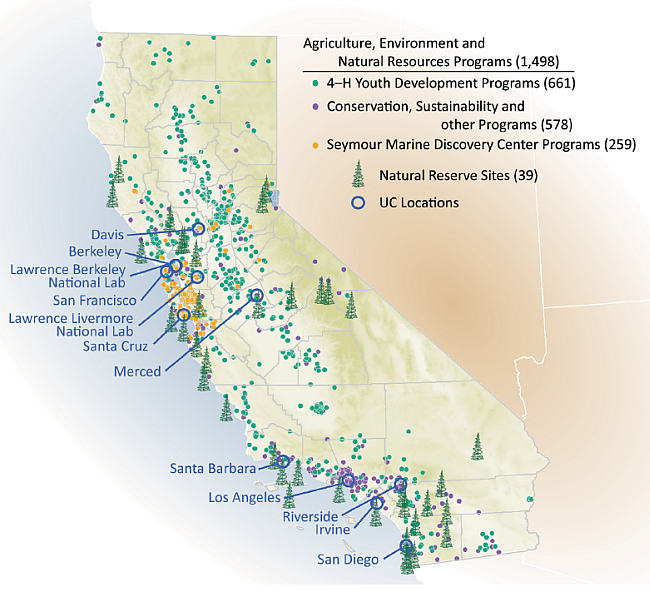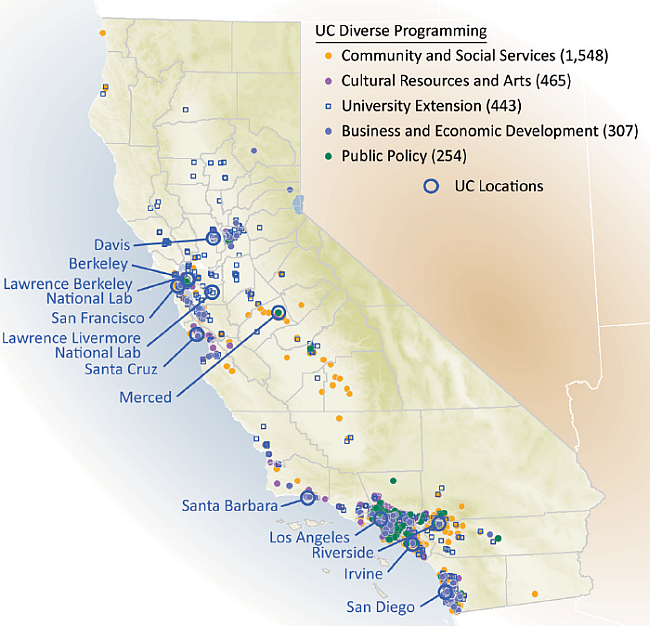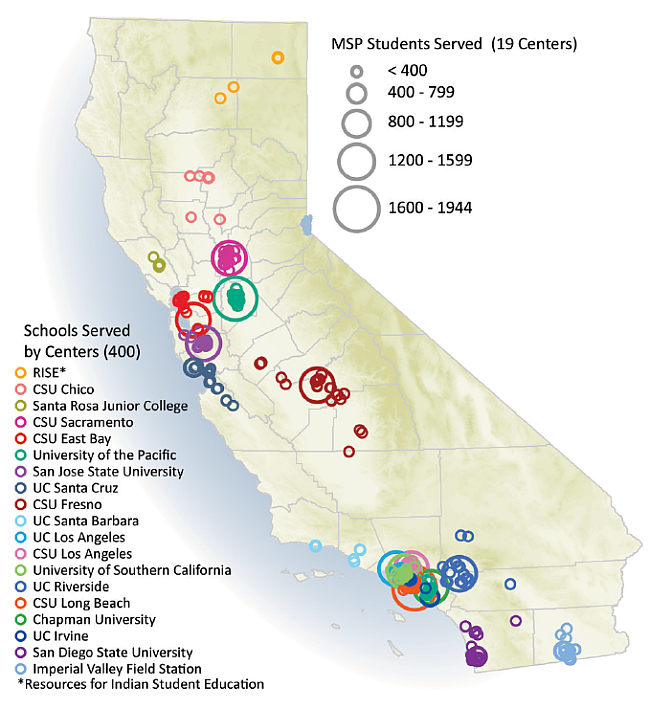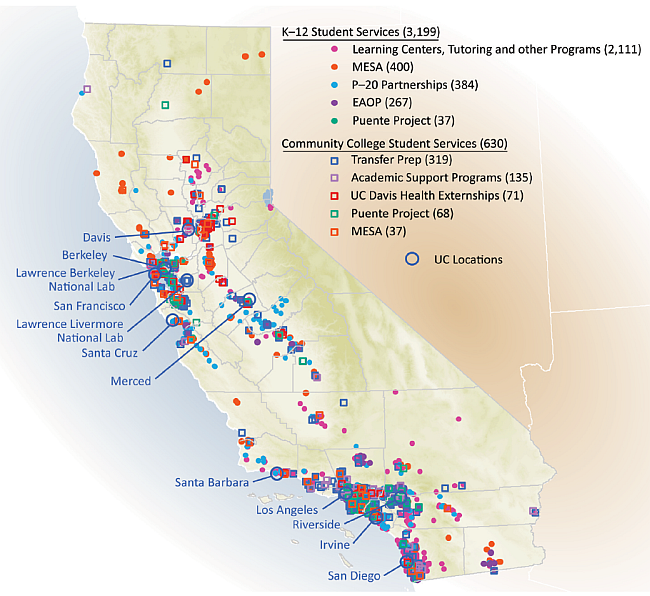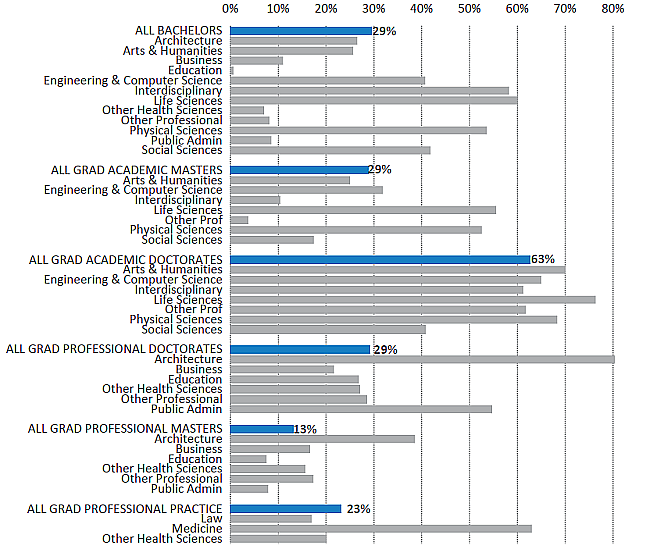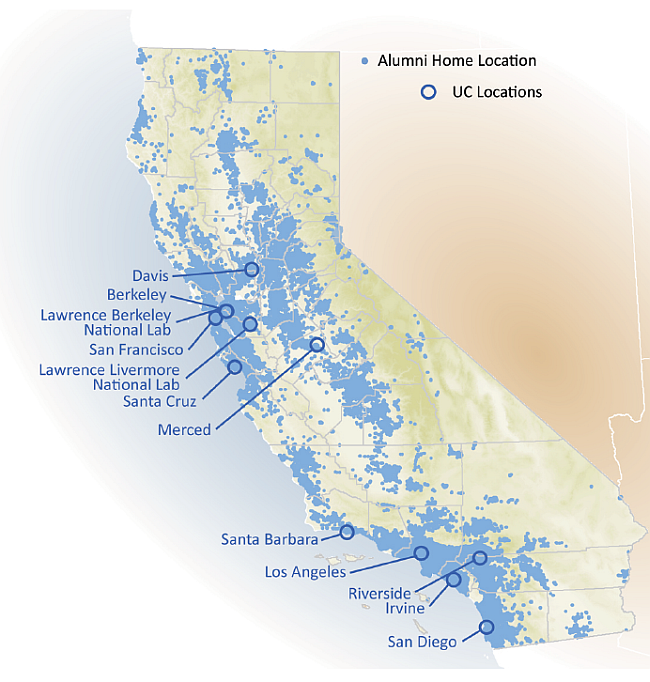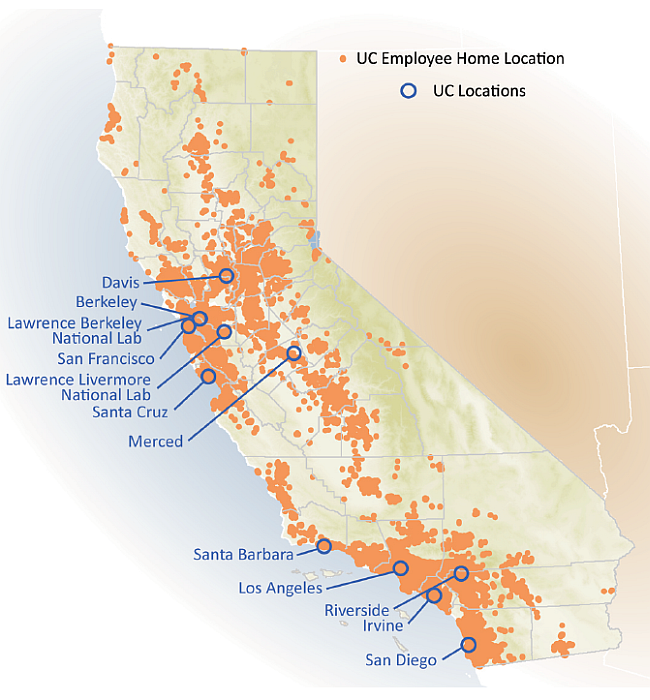UC's statewide impact
UC’s direct impact on the state of California extends well beyond its campuses and laboratories, and touches every community throughout the state. UC contributes significantly to the state’s growth and the well-being of its population through its public service mission, which has been a fundamental and defining feature of UC throughout its history.
The faculty, students and staff at the University of California are engaged in a wide variety of public service activities connecting them with children, youth and adult residents across every region of the state. This chapter highlights some key aspects of life in California where UC’s impact has been and continues to be profound: agriculture, environmental stewardship, health, education at all levels and the overall economy.
THE PUBLIC SERVICE MISSION AT UC
Since its founding in 1868, UC’s public service mission has been closely connected to its other two missions of teaching and research. The University’s origins can be traced to the Morrill Land-Grant Act of 1862, which enabled states to use federal lands to establish colleges “to teach such branches of learning as are related to agriculture and the mechanical arts,” along with scientific and classical studies. UC was chartered as California’s only land-grant university. Subsequent federal legislation expanded the mission of the nation’s land-grant institutions to conduct research in agricultural experiment stations and to connect that research with local communities throughout each state.
In the early 1900s, the Division of Agricultural Extension was established in the College of Agriculture at UC Berkeley, and the Cooperative Extension system began developing as extension agents were posted in counties across California. Since then, their goal has been to advance California’s agriculture sector by promoting innovation and scientific discovery, and by diffusing research results and expertise throughout the state.
Agricultural extension and research
Today, agricultural research activities at UC are managed through the Agricultural Experiment Station (AES), a multi-campus organized research unit located on the Berkeley, Davis and Riverside campuses, and coordinated systemwide through the Division of Agriculture and Natural Resources. AES scientists are one of the driving forces behind California’s $46 billion agriculture sector. The AES also provides worldwide leadership in promoting agricultural and environmental sciences, nutrition and youth development.
UC’s statewide Cooperative Extension (CE) system continues its applied research and outreach activities, and has local offices working in nearly every county in California. CE encompasses a national, nonformal education system that links educational and research activities and resources of the U.S. Department of Agriculture (USDA), the nation’s land-grant universities, and county administrative units. CE activities focus on identifying critical and emerging needs in agricultural, natural and human resources, and on working with campus partners to develop research-based approaches to local problems.
These two divisions, the Agricultural Experiment Station and the Cooperative Extension, merged in 1975 under the leadership of the systemwide Division of Agriculture and Natural Resources (ANR). Using federal, state, county and nongovernmental funding, AES and CE implement close to 1,500 local partnership programs. In addition, ANR encompasses nine research and extension centers, and 57 offices throughout California, housing 700 academic researchers.
ANR serves as the bridge between local agricultural and environmental issues and the power of the University of California. ANR works hand in hand with communities and industry to enhance agricultural markets, address environmental concerns, protect plant health, offer hands-on science-based learning for youth, promote youth development and provide farmers with scientifically tested production techniques. In addition, ANR manages six statewide programs and other local programs designed to promote healthy families and communities, including programs focused on sustainable, safe and nutritious food production and delivery.
Environmental stewardship
UC’s public service mission has evolved well beyond its agricultural origins over the last century, and UC’s extensive portfolio of environmental stewardship activities is a natural outgrowth of this legacy. ANR manages a wide network of conservation and sustainability programs addressing critical issues of our time, such as climate change, drought and food insecurity. In addition, within ANR, two of the UC Research and Extension Centers contain over 10,000 acres of oak woodland/annual grassland dedicated to research and education in both managed and undisturbed environments.
The University of California directly manages natural reserve lands that represent most state ecosystems. The UC Natural Reserve System comprises 39 sites with more than 756,000 acres across California. These lands enhance the University’s mission of teaching and research by providing undisturbed environments for students and faculty members to conduct research and enhance students’ opportunities to engage in meaningful educational experiences. The Merced Vernal Pools and Grasslands reserve next to UC Merced is the latest addition to the system.
Health
Promoting healthy outcomes for all Californians is an important element of UC’s public service mission. Managed through ANR, UC has nearly 1,100 community partnership programs focused on understanding obesity and healthy choices. Their activities include designing nutrition workshops to help limited-resource clients gain the knowledge, skills and attitudes they need to choose sound diets and improve their well-being.
The intersection of UC’s research and training missions is key when it comes to addressing health needs. Chapter 9 describes how UC research activities, particularly clinical trials, help improve health outcomes of all Californians by understanding disease processes and finding effective treatments. Chapter 11 describes UC’s key role in training California’s health care workforce and providing direct care to residents in the state.
Beyond these functions, UC’s five medical centers serve as the state’s fourth largest health care delivery system and engage in a wide range of activities to address the needs of specific populations. For example, UC’s five medical centers maintain long-term institutional partnerships with regional Veterans Affairs Health Care systems. In addition to conducting research on health issues of concern to veterans, such as traumatic brain injury and post-traumatic stress disorder, UC faculty and medical students provide quality care for several thousand veterans annually through the VA.
UC also expands its health outreach efforts through telemedicine. In this way, UC health care experts provide care for patients living in rural areas or in areas where specialty medical experts are not available. Telemedicine activities include real-time video and phone consultations between UC health care specialists and staff in clinics, hospitals, emergency rooms and intensive care units located throughout the state.
Education partnerships
For more than 40 years, the University of California’s Student Academic Preparation and Educational Partnership (SAPEP) programs have helped prepare California students for higher education and increase their access to post-secondary institutions. SAPEP programs such as the Early Academic Outreach Program (EAOP); the Mathematics, Engineering, Science Achievement (MESA) program; and the Puente project are designed to improve academic preparation for students in a variety of disciplines.
In addition to the activities UC undertakes to strengthen many K–12 students and community college students academically, UC plays an important role in preparing California’s teacher workforce. UC’s Teacher Education Programs prepare teacher candidates to engage students in rigorous, relevant and inquiry-based educational experiences. Located at eight UC campuses, Teacher Education Programs recruit, prepare and support pre-service educators who are committed to the principles of academic excellence, equity and integrity, and to cultivating the highest levels of achievement and opportunity for all students.
UC provides continued support to teachers already in the workforce through a variety of professional development programs. For example, the California Subject Matter Project (CSMP), a network of nine discipline-based statewide programs, provides professional development for teachers at about 5,000 schools and builds teacher leadership through about 120 teacher preparation programs across the state. CSMP also supports collaborative networks between K–12 educators and UC faculty.
UC’s economic impact
As California’s economy becomes increasingly dependent on highly educated workers, the role of the University of California in training the state’s future workforce becomes ever more vital. Industries relying on skilled workers in the STEM fields (science, technology, engineering and mathematics) represent a major component of California’s economy. UC awards half of the state’s bachelor’s degrees in STEM fields.
UC’s operations also add significantly to the state’s economy, as it is one of California’s largest employers. With expenditures of about $26.7 billion, much of that in the form of salaries, wages and benefits, UC annually generates more than $46 billion in economic activity in California. UC contributes more than $32 billion to the gross state product and attracts over $8 billion in annual funding from outside the state.
True to its land-grant mission, the UC system touches most aspects of what matters to us as a society. The UC public service mission has evolved in tandem with the changing needs of our state and our local communities, and has developed innovative programs and partnerships that improve the lives of all Californians.
FOR MORE INFORMATION
Interactive map application: includes Assembly districts and campus info
Division of Agriculture and Natural Resources
Natural Reserve System
MESA Programs
California Subject Matter Project
UC InfoCenter: UC’s role educating California’s workforce
UC InfoCenter: The STEM degree pipeline
UC InfoCenter: UC’s undergraduate alumni employment outcomes
UC InfoCenter: UC faculty and staff ’s faculty and staff
